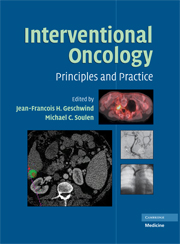Book contents
- Frontmatter
- Contents
- FOREWORD
- ACKNOWLEDGMENTS
- CONTRIBUTORS
- PART I PRINCIPLES OF ONCOLOGY
- 1 Biology of Cancer
- 2 Evaluation of the Cancer Patient
- 3 Principles of Chemotherapy
- 4 Pharmacologic Principles of Regional Therapy in the Treatment of Liver Metastases or Primary Liver Tumors
- PART II PRINCIPLES OF IMAGE-GUIDED THERAPIES
- PART III ORGAN-SPECIFIC CANCERS
- PART IV SPECIALIZED INTERVENTIONAL TECHNIQUES IN CANCER CARE
- INDEX
- Plate section
- References
4 - Pharmacologic Principles of Regional Therapy in the Treatment of Liver Metastases or Primary Liver Tumors
from PART I - PRINCIPLES OF ONCOLOGY
Published online by Cambridge University Press: 18 May 2010
- Frontmatter
- Contents
- FOREWORD
- ACKNOWLEDGMENTS
- CONTRIBUTORS
- PART I PRINCIPLES OF ONCOLOGY
- 1 Biology of Cancer
- 2 Evaluation of the Cancer Patient
- 3 Principles of Chemotherapy
- 4 Pharmacologic Principles of Regional Therapy in the Treatment of Liver Metastases or Primary Liver Tumors
- PART II PRINCIPLES OF IMAGE-GUIDED THERAPIES
- PART III ORGAN-SPECIFIC CANCERS
- PART IV SPECIALIZED INTERVENTIONAL TECHNIQUES IN CANCER CARE
- INDEX
- Plate section
- References
Summary
The rationale for regional chemotherapy is to maximize drug concentrations and tumor drug uptake in the target organ and minimize systemic toxicity (1). For regional drug delivery to successfully impact relevant outcomes, several important principles regarding tumor biology, drug pharmacology and delivery systems must be fulfilled (2). The model of liver metastasis from colorectal cancer complies with these principles, as colorectal cancer has a regional pattern of dissemination, with the liver being the only site of metastatic disease for long periods in some cases (3). Other salient features include the selective supply of blood to liver metastases by the hepatic artery (4) and availability of active drugs with suitable pharmacokinetic properties (5).
In this chapter, pharmacological concepts of regional therapy will be reviewed. Desirable pharmacokinetic and pharmacodynamic characteristics of drugs considered for evaluation in the hepatic arterial infusion (HAI) model of regional drug delivery will be discussed, using floxuridine (FUDR) as a model, in the context of patients with colorectal liver-only metastases (CRLM). Also, an evaluation of the pharmacology of currently approved agents for the treatment of metastatic colon cancer and their hypothetical value for regional drug delivery will be preformed. Results of Phase I and Phase II trials of HAI with these drugs, if available, will be explained in terms of the previously established pharmacologic rationale. Finally, for active drugs not already tested, a critical analysis will be done of the available pharmacokinetics data to determine the likelihood of successful incorporation of these drugs to HAI-based therapeutics.
- Type
- Chapter
- Information
- Interventional OncologyPrinciples and Practice, pp. 38 - 52Publisher: Cambridge University PressPrint publication year: 2008
References
- 1
- Cited by



